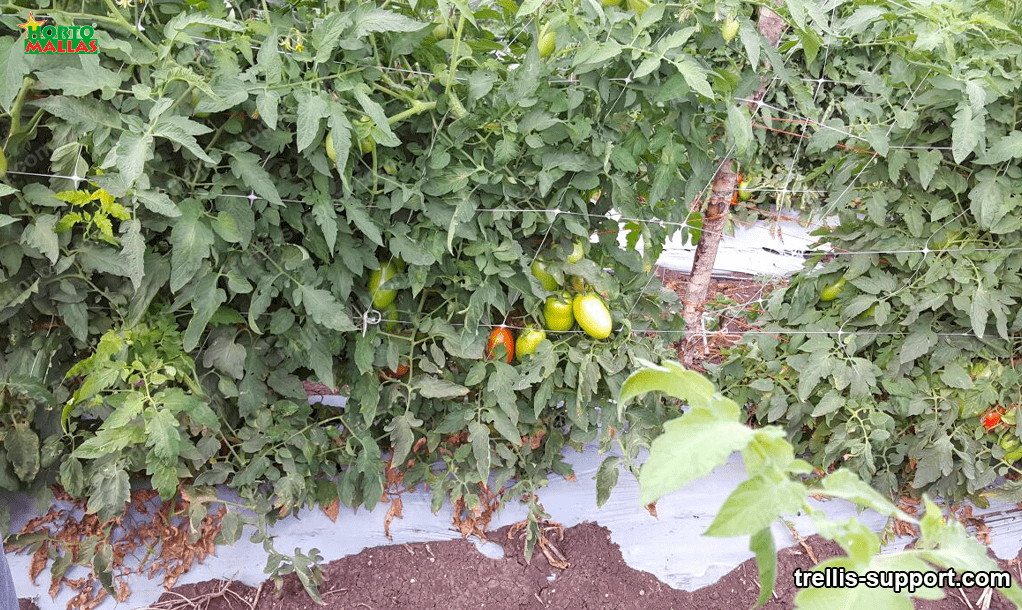This mesh is useful to support the plant. In this way, it prevents the plant from breaking or leaning too much. The mesh is tied to a stake, which is inserted into the soil. This mesh also allows the realization of various systems to support and tutor the plant, from the conventional one using stakes, to automated systems such as automatic supports and tutors. A well tutored orchard is characterized by plants with greater vigor and with an adequate shape, all of them better monitored and with a firm support. This avoids competition between the roots themselves, as they are better distributed along the soil. In addition, the trellising structure helps to maintain the humidity and temperature of the orchard. This is thanks to the shade that is formed over the plant.
This helps prevent the growth of weeds in the garden by reducing the sunlight they need to develop. It is also useful to protect the plants from the wind, which is indispensable for orchards in areas with extreme weather conditions. Especially, this type of netting is recommended in those gardens whose plants have fragile stems such as petunias, gladiolus, tomatoes, among others. An additional benefit of using this mesh for trellising is the limitation of diseases caused by pests such as cockroaches, caterpillars, slugs and all kinds of insects. This is because the mesh acts as a barrier between these insects and the orchard. The trellising netting gives the orchard a tidy, clean and professional appearance, as it prevents the formation of anchored ditches and the formation of paths with bark from the seedlings.
Structures for the installation of trellising structure
Mesh structures for crop trellising offer numerous benefits for growers and gardeners. In addition to creating a natural framework for growing plants, they also provide support for flexible stems and hanging flowers. Mesh trellising structures can be made of plastic, metal, wire, wood and other materials, and generally require careful assembly for best results. These instructions will help you learn how to design and build mesh trellising structures that provide secure support and maintain the beauty of your garden. Before you begin designing your trellising structure, you should consider your needs. A garden of herbaceous vegetables such as beans, chilies and peppers will not require the same structure as a vine for grape production. Be aware of the plant’s requirements.
A fruit tree such as an apple will gradually need more support as the tree grows, and hanging vegetables and flowers have delicate requirements to support their stem without causing damage. Once you have decided on the appropriate structure for the trellising netting, you need to mark the posts so you know where to place them. The posts will be responsible for supporting the mesh, so a precise design is needed for a solid structure. Look for the location of the posts. The most suitable space should provide sufficient depth for the post hole. The hole should be at least two feet deep and six to eight inches in diameter. If there is any doubt about the amount of depth needed, the posts should be dug even deeper. Once the posts are dug, they will be filled with concrete.
What does mesh support provide?
This will ensure that the post will stay in place and not move over time. Once the concrete has dried, the posts will be nailed in place with the nut mesh clamps. The mesh must be of good quality to support the weight of the plant well. The mesh should be bent to form a proper angle as it rises from the ground. The angle is the key to ensuring that the mesh does not separate from the posts over time. Tension on the posts and wire should always be avoided, as this can result in an unsafe structure. After this step, and the mesh has been nailed to the posts, it is recommended that the mesh be attached to a group of posts with fine wire. This will hold the mesh in place over time and provide additional support for the plant support.
Depending on whether it is used for a herbaceous vegetable garden, vines, or other types of plants, spectacular ribbons, fine wire, galvanized wire, or other materials can be used to attach the plant stems to the mesh. After the structure has been designed, constructed and installed, it is necessary to check the work to ensure that the structure is safe and working properly. This includes a periodic inspection to make sure that the posts and mesh are secure, that all fastening materials are in good condition and that the structure is visible. This will allow your structure to last a long time. The construction of mesh trellising structure is a relatively simple process, but must be followed closely to avoid any damage to the plants, the garden and the environment.
